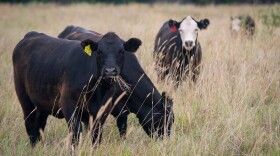Much of the Great Plains is experiencing drought: So far, at least half of Nebraska, Kansas, and Iowa, and Oklahoma are abnormally dry, with large areas experiencing severe drought.
As harvest draws to a close, farmers inNebraska,Iowa, andOklahomaare seeing easier harvests but reduced yields due to dryness. Overall, reports from the U.S. Department of Agriculture suggest most crops held their own this summer, with both soybean and corn harvestsonce more predicted to hit record levels. But a lack of fall rain could spell problems for farmers in the spring.
Brian Fuchs at the National Drought Center says soils across the Great Plains have one job now: recharge.
“Any moisture that we can add into the soil now — before we have the soils freeze up — is going to be moisture that is available next spring when we plant that next crop,” he said.
“And the same thing goes with the grasses in the pasture lands … those grasses will stop growing as much when we see temperatures decline and the amount of sunlight declines.”
Fuchs says drought conditions accelerated quickly this summer in several states like Nebraska.
“Since July, we've had a 67% increase in drought,” he said. “So not only have we seen drought continue to develop in the state, but we've also seen drought intensification.”
That escalation coupled with stubbornly warm, dry days at the end of the growing season is making crop watchers nervous for the 2021 season.
“Even though plants and crops are not using that moisture, we're still losing some of that moisture with the temperatures and windy conditions,” Fuchs explained. “I do know out in western Nebraska, winter wheat has been planted into some fairly dry soils … that crop is off to a poor start.”
Given the La Niña weather pattern in effect, Southern states are likely to stay dry while the north sees snow and rain. But Fuchs says there is room for variation and some welcome rain across the region.
“Where we see storm tracks set up here and at the end of November, early December, that's really going to dictate what portions of the plains see the most active weather.”
Copyright 2020 Harvest Public Media







